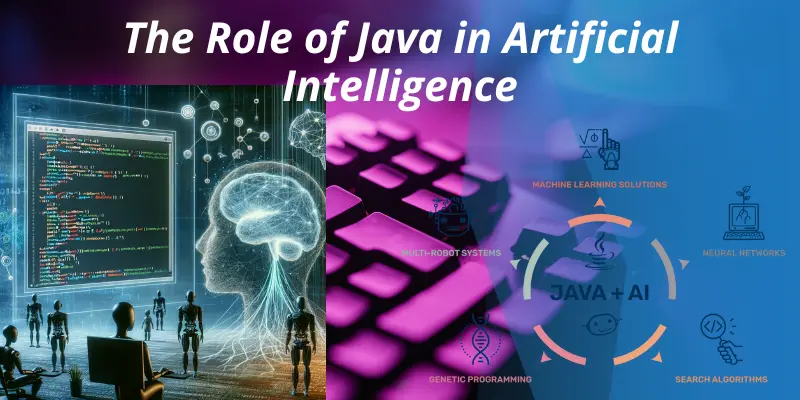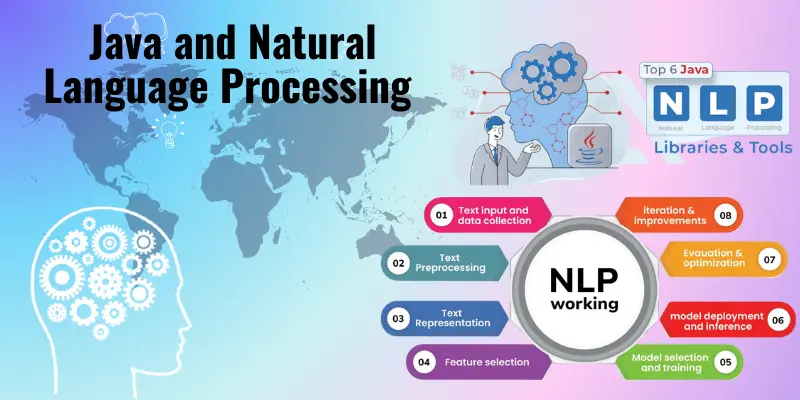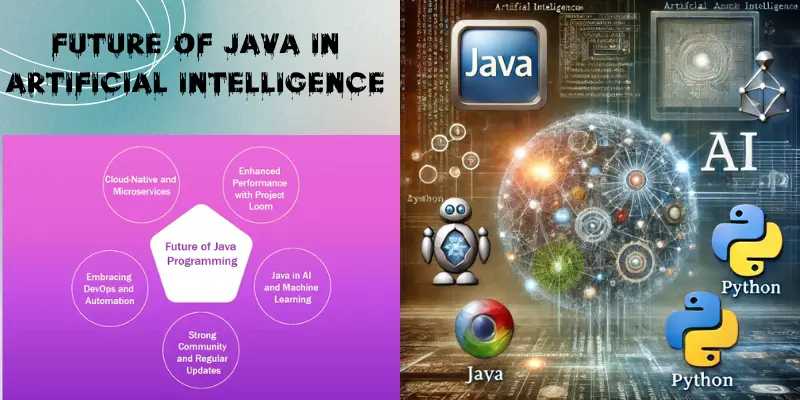Java and Artificial Intelligence – Powering Future AI System
Published: 27/04/2025
Java and Artificial Intelligence have become a powerful combination, transforming the way we build intelligent systems. Java, known for its simplicity and reliability, provides a solid foundation for developing AI applications that are both scalable and efficient. With the increasing demand for smarter applications, developers are turning to Java to implement artificial intelligence in areas like machine learning, data processing, and automation. This synergy between Java and AI is enabling the creation of smarter software solutions that can learn, adapt, and make decisions on their own, shaping the future of technology.
Table of Contents
The Role of Java in Artificial Intelligence
Java plays a vital role in the development of Artificial Intelligence by offering a reliable, platform-independent environment for building intelligent systems. Its strong object-oriented structure makes it ideal for handling the complexity involved in AI programming. Java is rich set of libraries and frameworks, such as Deeplearning4j and Weka, allow developers to seamlessly integrate machine learning and deep learning models into their applications.

Additionally, Java’s scalability and performance make it an excellent choice for AI projects that require heavy data processing or real-time decision-making. Whether it’s developing a chatbot, creating an intelligent recommendation system, or building predictive analytics tools, Java’s contribution to AI continues to grow, enabling businesses and developers to create innovative, smart solutions.
Important Java Tools and Libraries for AI
Java offers several powerful tools and libraries that make developing AI applications easier and more efficient.
- Deeplearning4j
- This is a popular deep learning library for Java. It allows developers to build neural networks and deep learning models, enabling complex tasks like image recognition and natural language processing. It supports GPUs for faster training of large datasets.
- Weka
- Weka is a machine learning library that offers a wide range of algorithms for data mining and predictive modeling. It provides tools for classification, regression, clustering, and association rule mining, making it ideal for building AI models.
- MOA
- Designed for data stream mining, MOA is used to build real-time AI applications. It can process continuous data and is especially useful for applications in finance, telecommunications, and IoT, where data flows in real-time.
- Encog
- A powerful machine learning library that supports neural networks, genetic algorithms, and other machine learning algorithms. Encog is often used in creating intelligent systems for robotics, healthcare, and more.
- Apache Mahout
- Known for its scalability, Apache Mahout is used for building scalable machine learning algorithms for large data sets. It helps with clustering, classification, and collaborative filtering, making it suitable for AI in big data projects.
- Java-ML
- A simple machine learning library that includes a wide variety of algorithms for classification, clustering, and regression. It is lightweight and easy to use, making it perfect for developers who are just getting started with AI in Java.
How Java Helps in Machine Learning
Java plays a significant role in the field of Machine Learning (ML) by offering a robust and efficient environment for building ML models. Here’s how Java helps in machine learning:
- Libraries and Frameworks
- Java provides powerful libraries and frameworks like Weka, Deeplearning4j, and Apache Mahout. These libraries contain pre-built machine learning algorithms for tasks like classification, regression, clustering, and data mining, making it easier to develop ML models without starting from scratch.
- Performance and Scalability
- Java’s performance is one of its key strengths. It can handle large datasets and perform computationally intensive tasks quickly, making it suitable for training complex ML models. Java’s scalability ensures that machine learning models can grow as the data increases, allowing developers to work with big data efficiently.
- Portability
- One of the biggest advantages of Java is its platform independence. Once a machine learning model is created in Java, it can run on any platform without needing major adjustments, thanks to Java’s “Write Once, Run Anywhere” principle.
- Integration with Big Data Tools
- Java seamlessly integrates with big data tools like Hadoop and Spark, which are often used for large-scale data processing. This makes it easier to apply machine learning algorithms to big data, enabling more accurate predictions and insights.
- Ease of Use
- Java’s object-oriented nature and strong typing make it easier for developers to maintain and scale machine learning projects. The clear structure of Java code helps prevent errors and makes the code more readable, which is crucial for long-term ML projects.
- Real-Time Decision Making
- Java’s ability to handle real-time processing is essential for machine learning applications that require live data input. Whether it’s a recommendation system or a predictive analytics tool, Java can process and make decisions in real-time.
Java and Natural Language Processing (NLP)
Java has become an essential tool in the field of Natural Language Processing (NLP) due to its performance, versatility, and rich ecosystem of libraries. NLP involves enabling computers to understand, interpret, and generate human language, which is a challenging task that requires sophisticated algorithms and models. Java helps in NLP in the following ways:

- Libraries and Frameworks
- Platform Independence
- Scalability and Performance
- Integration with Big Data
- Real-Time Processing
- Machine Learning for NLP
Java for Expert Systems in AI
Expert Systems in Artificial Intelligence are designed to emulate the decision-making abilities of a human expert in a specific domain. Java plays a crucial role in building these systems due to its flexibility, scalability, and strong library support. Here’s how Java contributes to Expert Systems:
- Knowledge Representation
- Reasoning and Inference Engines
- Scalability
- Integration with Databases
- Decision Support
- User Interface
- Maintainability
Java and Robotics Using AI
Java is a powerful programming language that is increasingly being used in the development of robotics powered by Artificial Intelligence (AI). Robotics, when combined with AI, enables machines to perform tasks autonomously, adapt to environments, and make decisions based on real-time data. Java plays a vital role in building these intelligent robotic systems due to its versatility, scalability, and ease of integration. Here’s how Java contributes to robotics using AI:
- Control Systems
- AI Integration
- Real-Time Processing
- Sensor Data Processing
- Robotic Frameworks
- Autonomous Behavior
- Simulation and Testing
- Cross-Platform Compatibility
Java vs Python for Artificial Intelligence
| Aspect | Java | Python |
| Performance | Java is a compiled language, known for its speed and efficiency, especially in large-scale systems. It performs faster than Python in most cases due to its static typing and compiled nature. | Python is an interpreted language and usually slower than Java, especially in complex AI algorithms. However, for most AI tasks, this speed difference is negligible due to optimized libraries. |
| Ease of Use | Java has a more complex syntax compared to Python. Writing code in Java can be verbose, which may increase the development time for AI projects. | Python is known for its simplicity and readability. Its syntax is clean, making it a popular choice for AI development, especially for beginners and rapid prototyping. |
| Libraries and Frameworks | Java has fewer AI-specific libraries, but it supports robust tools for data processing and AI integration, like Deeplearning4j, Weka, and Apache Mahout. These are powerful for production systems but not as extensive for deep learning. | Python boasts a rich ecosystem of libraries tailored to AI and machine learning, such as TensorFlow, Keras, PyTorch, and Scikit-learn. These libraries are widely used for deep learning, neural networks, and machine learning. |
| Community Support | Java has a large and mature community, particularly in enterprise environments. However, its community for AI development is smaller compared to Python’s. | Python has an enormous and active AI community. The Python AI community frequently releases new tools and updates, making it one of the leading choices for AI development. |
| Learning Curve | Java’s learning curve is steeper due to its complex syntax and the need for understanding concepts like memory management, object-oriented principles, and more. | Python is easier to learn and more intuitive, which makes it a go-to language for AI development. Beginners can quickly start with AI concepts using Python. |
| Flexibility | Java offers strong flexibility and is ideal for large-scale enterprise applications. It’s widely used in production environments, especially for handling complex systems like AI in IoT, financial tech, and more. | Python is highly flexible but is mainly focused on AI, machine learning, and data science. It is not as suitable for building large-scale enterprise applications as Java. |
| Integration with Big Data | Java integrates well with big data technologies like Apache Hadoop, Apache Spark, and other distributed systems, making it a strong choice for large-scale AI projects that involve big data. | Python also supports big data technologies but is generally slower than Java when handling large volumes of data. However, libraries like PySpark make Python a good choice for big data analytics. |
| Concurrency and Multithreading | Java is known for its robust multi-threading and concurrency features, which are ideal for real-time AI applications that require parallel processing of multiple tasks. | Python, while having multi-threading capabilities, is generally not as strong in this area due to the Global Interpreter Lock (GIL). However, Python can still handle multi-threading through libraries like multiprocessing. |
| Deployment | Java applications are highly portable and can be easily deployed across multiple platforms. It is often preferred in enterprise environments where high performance and reliability are critical. | Python’s cross-platform capabilities are good but not as strong as Java’s. Python applications may require additional work to ensure smooth deployment on different platforms. |
| Job Opportunities | Java has significant job opportunities, especially in enterprise AI applications, such as in finance, healthcare, and manufacturing. However, the demand for AI roles in Java is somewhat less compared to Python. | Python dominates the AI job market, with many AI-focused startups, research institutions, and tech giants using Python for AI development. There are far more job opportunities for Python developers in AI. |
Future of Java in Artificial Intelligence
The future of Java in Artificial Intelligence (AI) holds great promise, especially in enterprise-level applications and large-scale systems. While Python currently leads in AI and machine learning development, Java’s role in AI is expected to continue growing due to several key factors:

- Integration with Big Data
- Enterprise Adoption
- Improved AI Libraries
- Real-Time AI Applications
- Compatibility with Cloud Services
Advantages and Disadvantages of Java in Artificial Intelligence
Java offers strong performance and scalability for AI but faces challenges like limited deep learning libraries.
Benefits of Java in Artificial Intelligence
Java offers speed, scalability, and powerful tools, making it a strong choice for Artificial Intelligence development.
| Pros of Java in Artificial Intelligence |
|---|
|
Drawbacks of Java in Artificial Intelligence
Java faces challenges in Artificial Intelligence due to its complex syntax, slower development speed, and fewer specialized AI libraries.
| Cons of Java in Artificial Intelligence |
|---|
|
Common FAQs about Java and Artificial Intelligence
Find quick answers about how Java supports Artificial Intelligence, machine learning, and AI applications.
Java is preferred for large-scale, production-level AI systems, while Python is better for research and quick prototyping.
Java can use libraries like Weka or Deeplearning4j to build machine learning models.
Yes, Java is excellent for real-time AI, especially in automation and robotics.
Java has verbose syntax, slower development, and fewer deep learning libraries than Python.
Java is strong for scalable, production AI systems, while Python dominates in research and quick prototyping.
Conclusion
Java continues to play a vital role in the development of Artificial Intelligence, especially for large-scale, enterprise-level applications. Its performance, security, and cross-platform capabilities make it ideal for AI in industries requiring robust and scalable solutions. While Python leads in rapid prototyping and deep learning, Java’s integration with big data, real-time systems, and robotics ensures its place in the evolving AI landscape. As AI technologies advance, Java’s stability and enterprise focus will remain essential for creating efficient, long-term AI solutions.

- Be Respectful
- Stay Relevant
- Stay Positive
- True Feedback
- Encourage Discussion
- Avoid Spamming
- No Fake News
- Don't Copy-Paste
- No Personal Attacks

- Be Respectful
- Stay Relevant
- Stay Positive
- True Feedback
- Encourage Discussion
- Avoid Spamming
- No Fake News
- Don't Copy-Paste
- No Personal Attacks





